2016 YAMAHA FZS SVHO warning
[x] Cancel search: warningPage 45 of 106
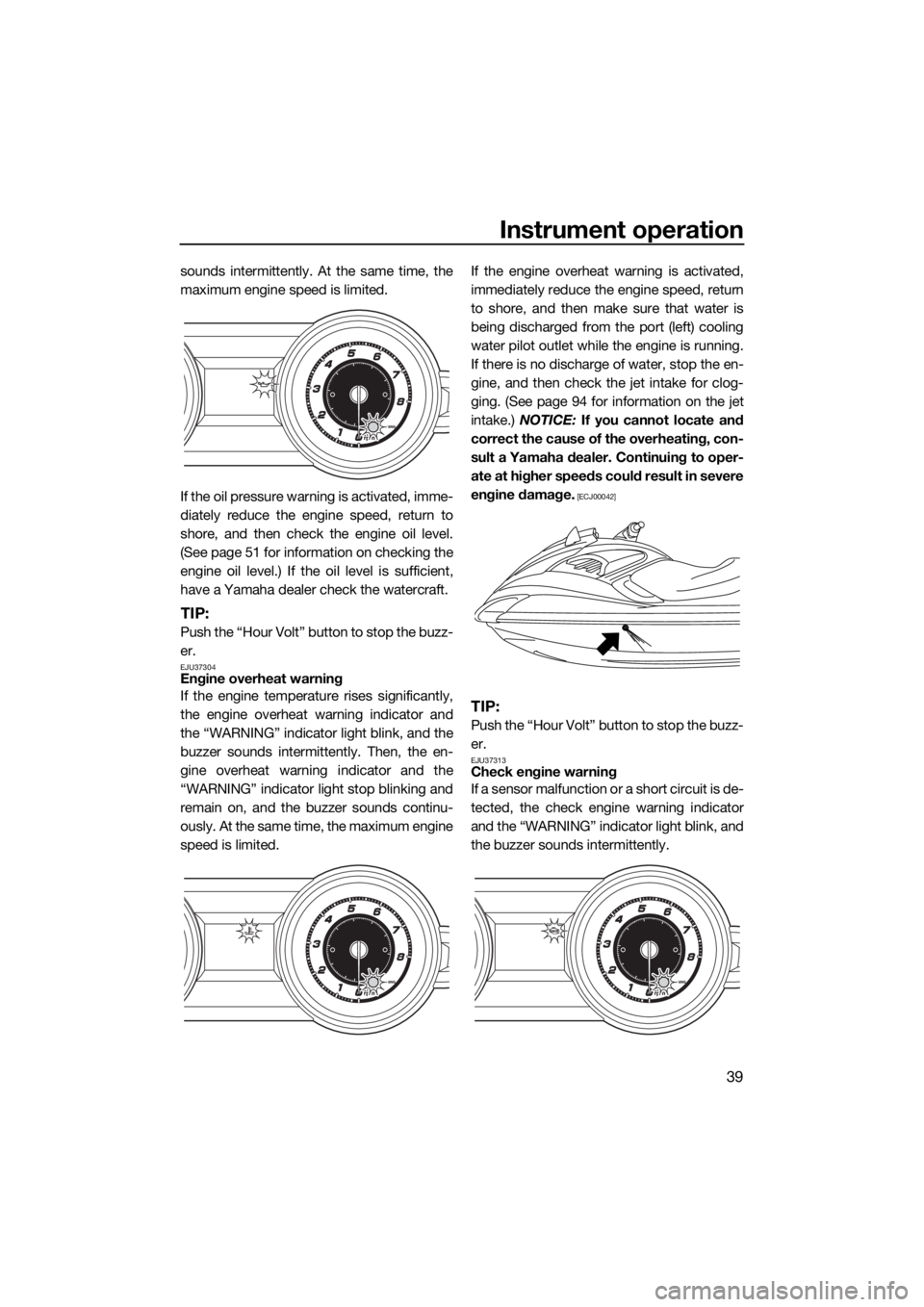
Instrument operation
39
sounds intermittently. At the same time, the
maximum engine speed is limited.
If the oil pressure warning is activated, imme-
diately reduce the engine speed, return to
shore, and then check the engine oil level.
(See page 51 for information on checking the
engine oil level.) If the oil level is sufficient,
have a Yamaha dealer check the watercraft.
TIP:
Push the “Hour Volt” button to stop the buzz-
er.
EJU37304Engine overheat warning
If the engine temperature rises significantly,
the engine overheat warning indicator and
the “WARNING” indicator light blink, and the
buzzer sounds intermittently. Then, the en-
gine overheat warning indicator and the
“WARNING” indicator light stop blinking and
remain on, and the buzzer sounds continu-
ously. At the same time, the maximum engine
speed is limited.If the engine overheat warning is activated,
immediately reduce the engine speed, return
to shore, and then make sure that water is
being discharged from the port (left) cooling
water pilot outlet while the engine is running.
If there is no discharge of water, stop the en-
gine, and then check the jet intake for clog-
ging. (See page 94 for information on the jet
intake.) NOTICE: If you cannot locate and
correct the cause of the overheating, con-
sult a Yamaha dealer. Continuing to oper-
ate at higher speeds could result in severe
engine damage.
[ECJ00042]
TIP:
Push the “Hour Volt” button to stop the buzz-
er.
EJU37313Check engine warning
If a sensor malfunction or a short circuit is de-
tected, the check engine warning indicator
and the “WARNING” indicator light blink, and
the buzzer sounds intermittently.
UF3K72E0.book Page 39 Thursday, July 16, 2015 2:31 PM
Page 46 of 106

Instrument operation
40
If the check engine warning is activated, im-
mediately reduce the engine speed, return to
shore, and have a Yamaha dealer check the
engine.
TIP:
Push the “Hour Volt” button to stop the buzz-
er.
UF3K72E0.book Page 40 Thursday, July 16, 2015 2:31 PM
Page 48 of 106
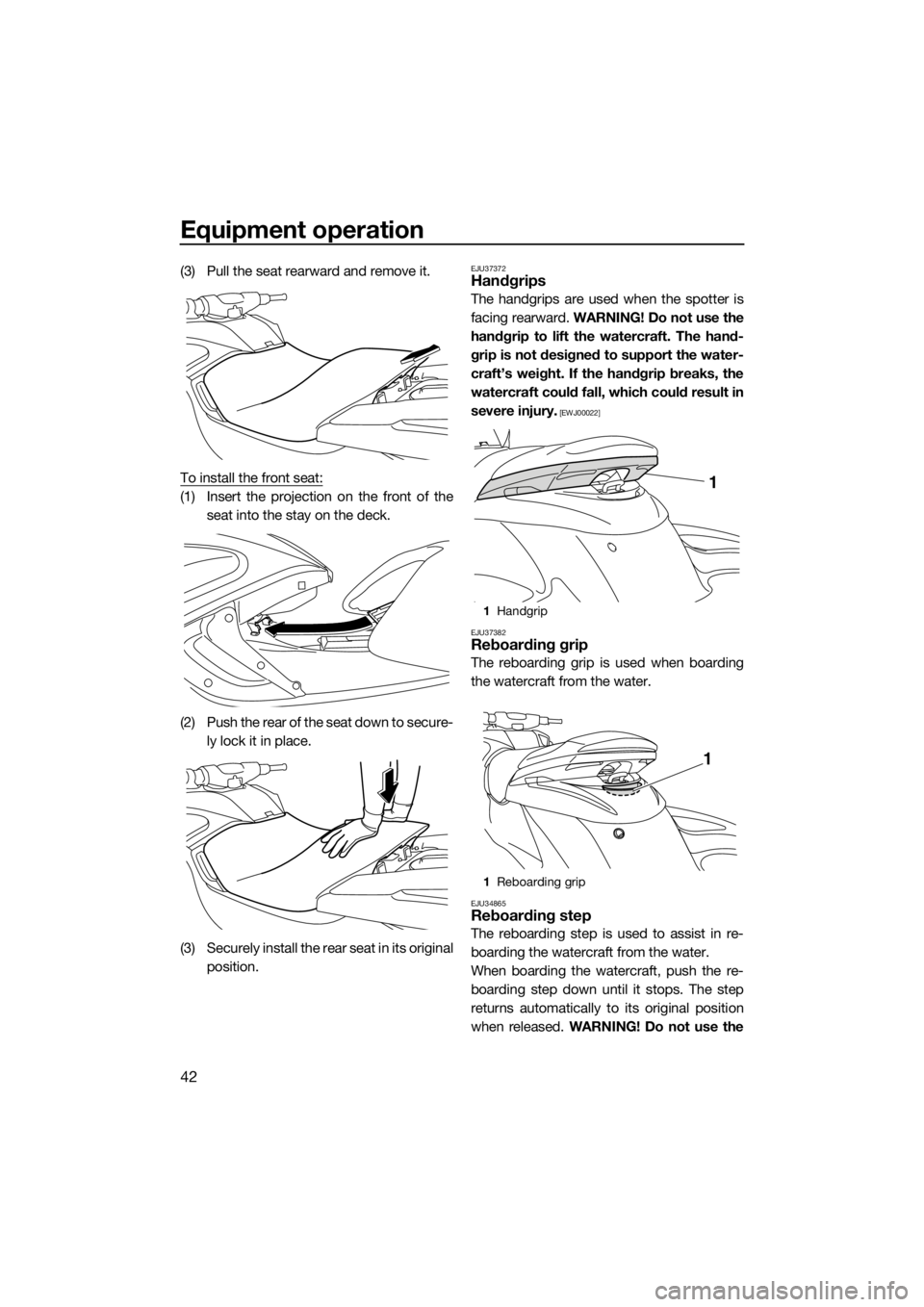
Equipment operation
42
(3) Pull the seat rearward and remove it.
To install the front seat:
(1) Insert the projection on the front of the
seat into the stay on the deck.
(2) Push the rear of the seat down to secure-
ly lock it in place.
(3) Securely install the rear seat in its original
position.
EJU37372Handgrips
The handgrips are used when the spotter is
facing rearward. WARNING! Do not use the
handgrip to lift the watercraft. The hand-
grip is not designed to support the water-
craft’s weight. If the handgrip breaks, the
watercraft could fall, which could result in
severe injury.
[EWJ00022]
EJU37382
Reboarding grip
The reboarding grip is used when boarding
the watercraft from the water.
EJU34865Reboarding step
The reboarding step is used to assist in re-
boarding the watercraft from the water.
When boarding the watercraft, push the re-
boarding step down until it stops. The step
returns automatically to its original position
when released. WARNING! Do not use the
1Handgrip
1Reboarding grip
1
1
UF3K72E0.book Page 42 Thursday, July 16, 2015 2:31 PM
Page 49 of 106
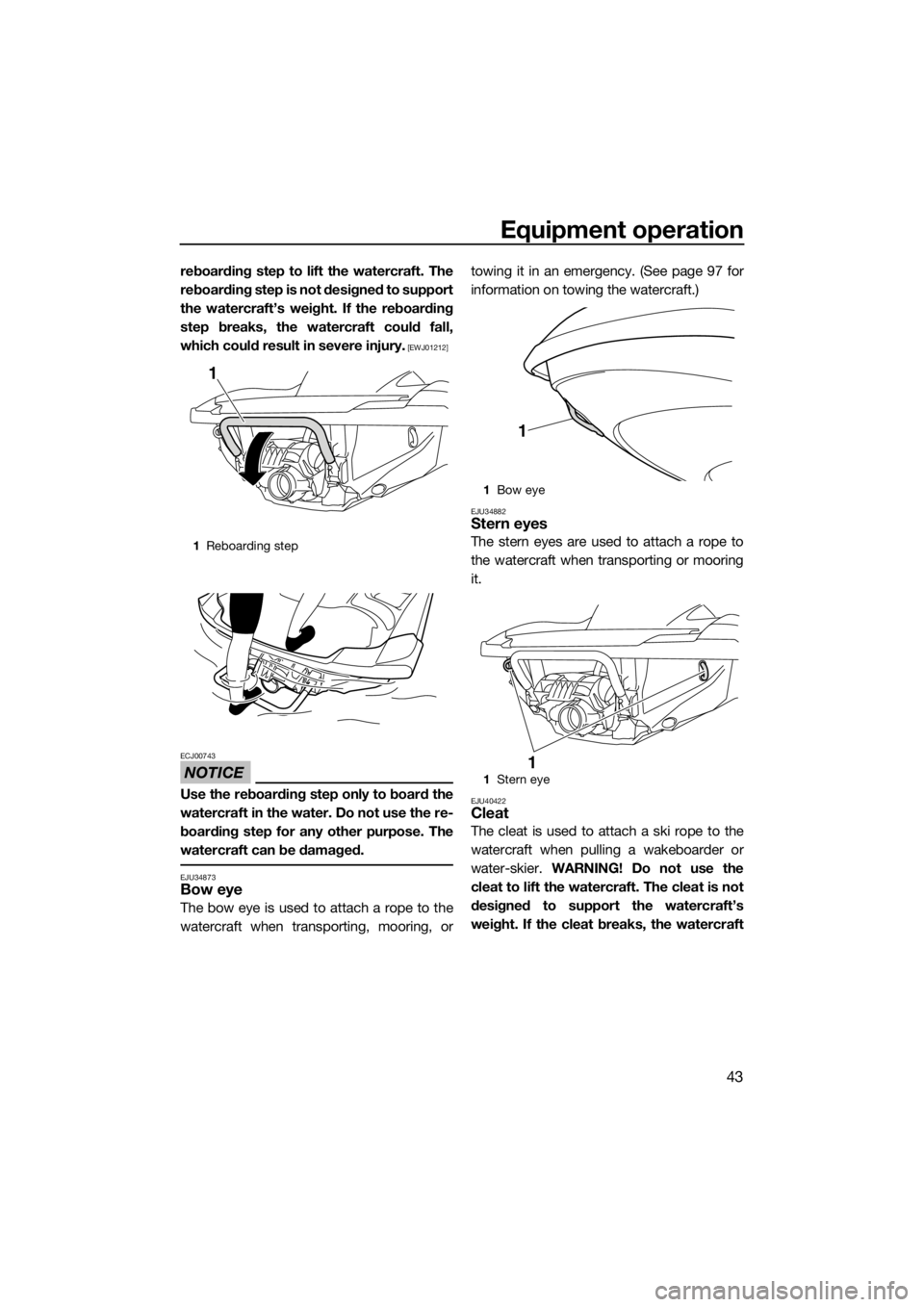
Equipment operation
43
reboarding step to lift the watercraft. The
reboarding step is not designed to support
the watercraft’s weight. If the reboarding
step breaks, the watercraft could fall,
which could result in severe injury.
[EWJ01212]
NOTICE
ECJ00743
Use the reboarding step only to board the
watercraft in the water. Do not use the re-
boarding step for any other purpose. The
watercraft can be damaged.
EJU34873Bow eye
The bow eye is used to attach a rope to the
watercraft when transporting, mooring, ortowing it in an emergency. (See page 97 for
information on towing the watercraft.)
EJU34882Stern eyes
The stern eyes are used to attach a rope to
the watercraft when transporting or mooring
it.
EJU40422Cleat
The cleat is used to attach a ski rope to the
watercraft when pulling a wakeboarder or
water-skier. WARNING! Do not use the
cleat to lift the watercraft. The cleat is not
designed to support the watercraft’s
weight. If the cleat breaks, the watercraft
1Reboarding step
1
1Bow eye
1Stern eye
1
1
UF3K72E0.book Page 43 Thursday, July 16, 2015 2:31 PM
Page 55 of 106

Operation and handling requirements
49
EJU31823
Fuel requirementsEJU41294Fuel
WARNING
EWJ00283
Gasoline and gasoline vapors are ex-
tremely flammable. To avoid fires and
explosions and to reduce the risk of in-
jury when refueling, follow these in-
structions.
Gasoline is poisonous and can cause in-
jury or death. Handle gasoline with care.
Never siphon gasoline by mouth. If you
should swallow some gasoline, inhale a
lot of gasoline vapor, or get some gaso-
line in your eyes, see your doctor imme-
diately. If gasoline spills on your skin,
wash with soap and water. If gasoline
spills on your clothing, change your
clothes.
NOTICE
ECJ01870
Do not use leaded gasoline. Leaded
gasoline can seriously damage the en-
gine.
Avoid getting water and contaminants in
the fuel tank. Contaminated fuel can
cause poor performance and engine
damage. Use only fresh gasoline that
has been stored in clean containers.
Use only gasoline with a minimum pump
octane number of 91 or a minimum re-
search octane number of 95. Low-oc-
tane gasoline can seriously damage the
engine.
Your Yamaha engine has been designed to
use premium unleaded gasoline with a pump
octane number [(R+M)/2] of 91 or higher, or a
research octane number of 95 or higher. Ifknocking (or pinging) occurs, use a gasoline
of a different brand.
Gasohol
There are two types of gasohol: gasohol con-
taining ethanol and that containing methanol.
Gasohol containing ethanol can be used if
ethanol content does not exceed 10% and
the fuel meets the minimum octane ratings.
E-85 is a fuel blend containing 85% ethanol
and therefore must not be used in this water-
craft. All ethanol blends containing more than
10% ethanol can cause fuel system damage
or engine performance problems.
Yamaha does not recommend gasohol con-
taining methanol because it can cause fuel
system damage and engine performance
problems.
To fill the fuel tank:
(1) Before refueling, stop the engine. Do not
stand or sit on the watercraft. Never refu-
el while smoking, or while in the vicinity
of sparks, open flames, or other sources
of ignition.
(2) Place the watercraft in a well-ventilated
area and in a horizontal position.
(3) Remove the seats, and then check the
fuel level. (See page 41 for seat removal
and installation procedures.) Recommended fuel:
Premium unleaded gasoline with a
minimum octane rating of
91
(Pump octane number) = (R + M)/2
95 (Research octane number)
UF3K72E0.book Page 49 Thursday, July 16, 2015 2:31 PM
Page 57 of 106
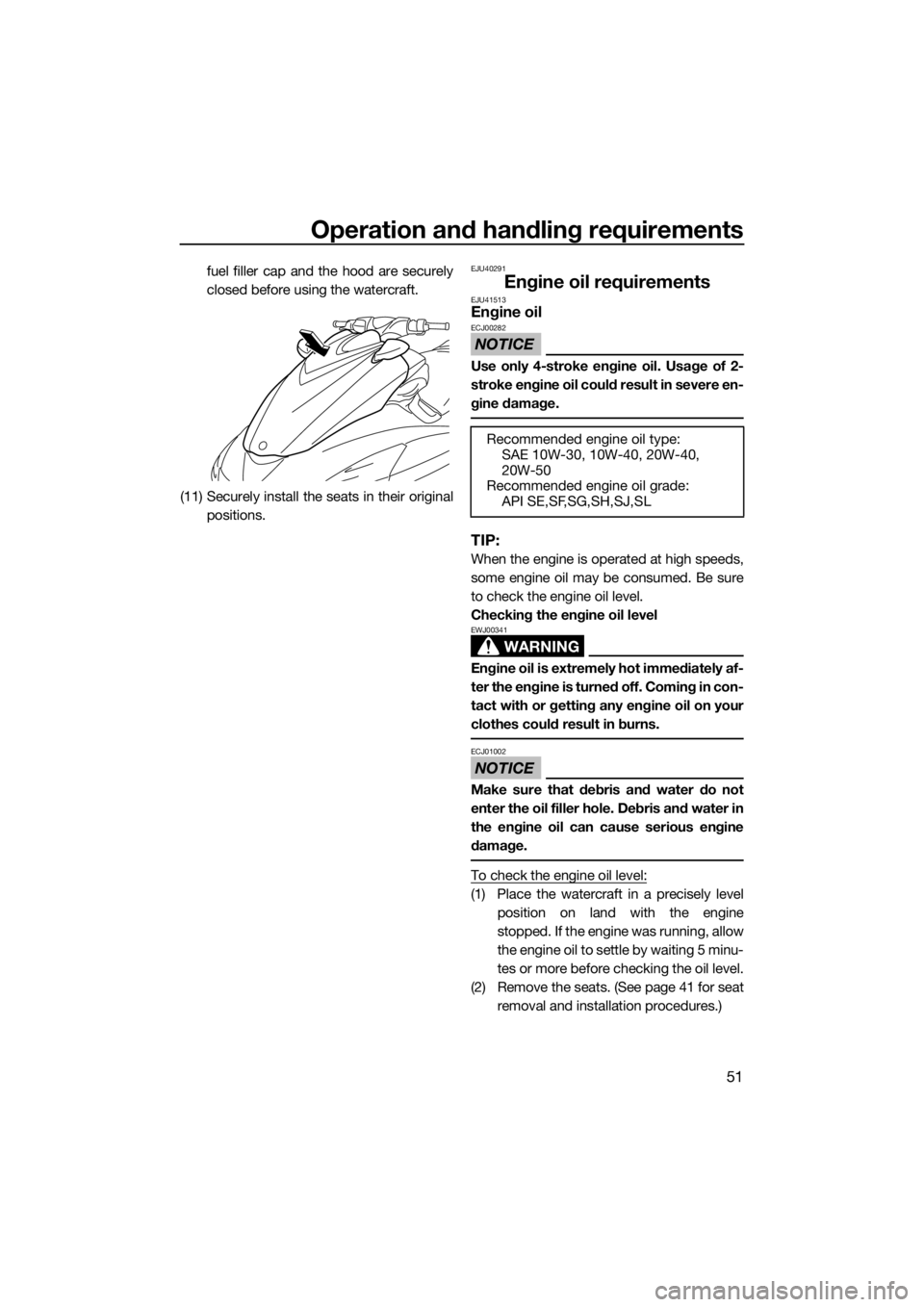
Operation and handling requirements
51
fuel filler cap and the hood are securely
closed before using the watercraft.
(11) Securely install the seats in their original
positions.EJU40291
Engine oil requirementsEJU41513Engine oil
NOTICE
ECJ00282
Use only 4-stroke engine oil. Usage of 2-
stroke engine oil could result in severe en-
gine damage.
TIP:
When the engine is operated at high speeds,
some engine oil may be consumed. Be sure
to check the engine oil level.
Checking the engine oil level
WARNING
EWJ00341
Engine oil is extremely hot immediately af-
ter the engine is turned off. Coming in con-
tact with or getting any engine oil on your
clothes could result in burns.
NOTICE
ECJ01002
Make sure that debris and water do not
enter the oil filler hole. Debris and water in
the engine oil can cause serious engine
damage.
To check the engine oil level:
(1) Place the watercraft in a precisely level
position on land with the engine
stopped. If the engine was running, allow
the engine oil to settle by waiting 5 minu-
tes or more before checking the oil level.
(2) Remove the seats. (See page 41 for seat
removal and installation procedures.)
Recommended engine oil type:
SAE 10W-30, 10W-40, 20W-40,
20W-50
Recommended engine oil grade:
API SE,SF,SG,SH,SJ,SL
UF3K72E0.book Page 51 Thursday, July 16, 2015 2:31 PM
Page 62 of 106

Pre-operation checks
56
EJU31982
WARNING
EWJ00412
Failure to inspect or maintain the watercraft properly increases the possibility of an ac-
cident or damage to the watercraft. Do not operate the watercraft if you find any prob-
lem. If a problem cannot be corrected by the procedures provided in this manual, have
the watercraft inspected by a Yamaha dealer.
EJU41234Pre-operation checklist
Before using this watercraft, be sure to perform the checks in the following checklist.
ITEM ROUTINE PAGE
PRE-LAUNCH CHECKS
Engine compartmentVentilate the engine compartment.
Check inside the engine compartment for damage.58
Fuel systemCheck the fuel system for leakage.
Check the fuel level in the fuel tank.58
Water separatorCheck the water separator for water. 58
Engine unitCheck the exterior of the engine unit for damage. 59
Engine oil levelCheck the engine oil level. 59
Bilge waterCheck the engine compartment for bilge water. 59
BatteryCheck the battery connections and electrolyte level. 59
Steering systemCheck the steering system for proper operation. 60
Telescopic steering systemCheck the telescopic steering system for proper op-
eration and check that the handlebars are securely
locked in place.61
Q.S.T.S.Check the Q.S.T.S. for proper operation and check
that the Q.S.T.S. selector is securely locked in pla-
ce.61
Reverse systemCheck the reverse system for proper operation. 62
Throttle leverCheck the throttle lever for proper operation.
Check the throttle lever free play.62
Remote control transmitterCheck the remote control transmitter for proper op-
eration.63
Engine shut-off cord (lan-
yard)Check the engine shut-off cord (lanyard) for dam-
age.63
SwitchesCheck the start switch, engine stop switch, and en-
gine shut-off switch for proper operation.63
Storage compartmentsCheck the storage compartments for damage and
water.64
Fire extinguisher holder,
cover, and bandCheck the fire extinguisher holder, cover, and band
for damage.64
Fire extinguisherCheck the condition of the fire extinguisher. 64
UF3K72E0.book Page 56 Thursday, July 16, 2015 2:31 PM
Page 64 of 106
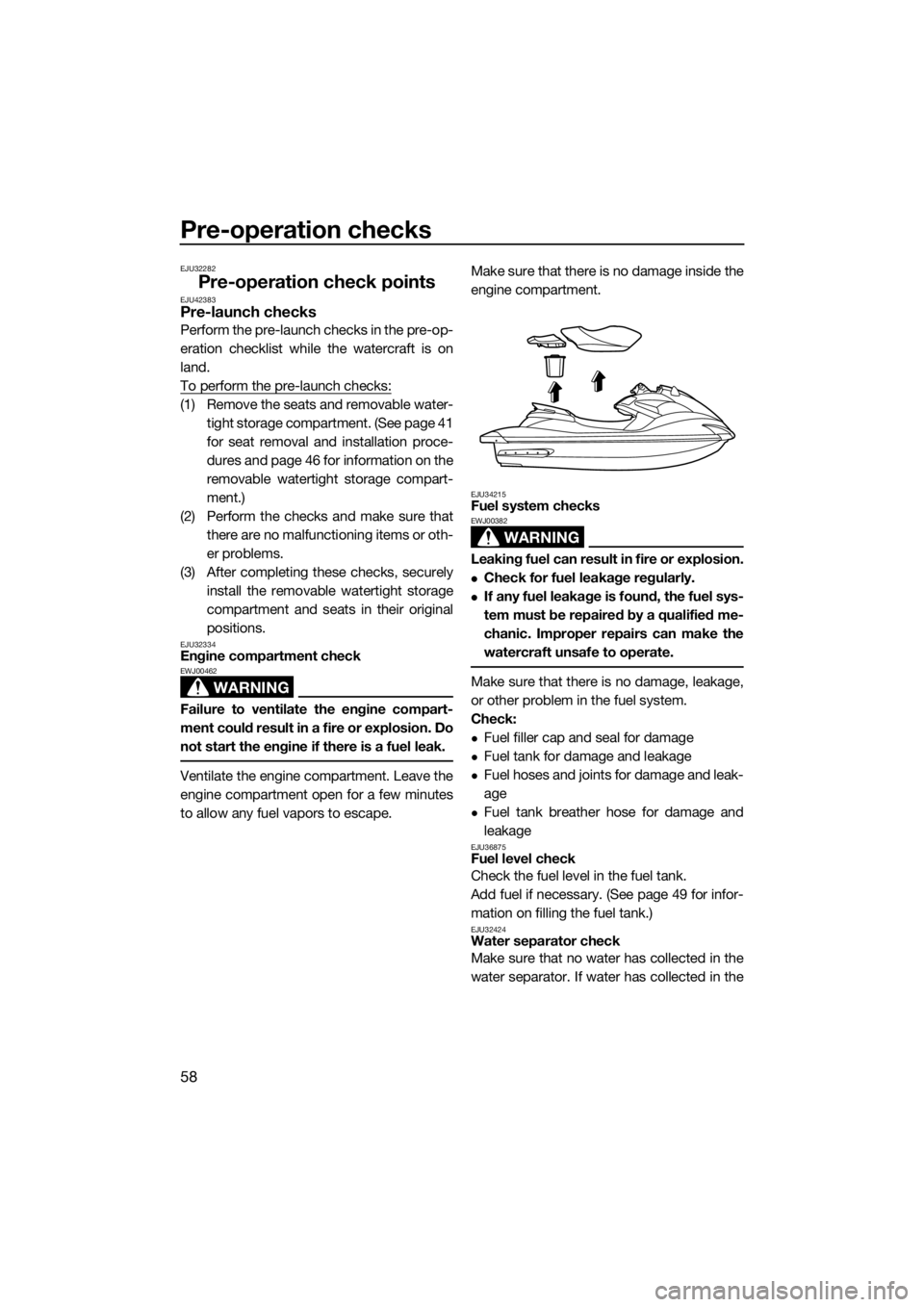
Pre-operation checks
58
EJU32282
Pre-operation check pointsEJU42383Pre-launch checks
Perform the pre-launch checks in the pre-op-
eration checklist while the watercraft is on
land.
To perform the pre-launch checks:
(1) Remove the seats and removable water-
tight storage compartment. (See page 41
for seat removal and installation proce-
dures and page 46 for information on the
removable watertight storage compart-
ment.)
(2) Perform the checks and make sure that
there are no malfunctioning items or oth-
er problems.
(3) After completing these checks, securely
install the removable watertight storage
compartment and seats in their original
positions.
EJU32334Engine compartment check
WARNING
EWJ00462
Failure to ventilate the engine compart-
ment could result in a fire or explosion. Do
not start the engine if there is a fuel leak.
Ventilate the engine compartment. Leave the
engine compartment open for a few minutes
to allow any fuel vapors to escape.Make sure that there is no damage inside the
engine compartment.
EJU34215Fuel system checks
WARNING
EWJ00382
Leaking fuel can result in fire or explosion.
Check for fuel leakage regularly.
If any fuel leakage is found, the fuel sys-
tem must be repaired by a qualified me-
chanic. Improper repairs can make the
watercraft unsafe to operate.
Make sure that there is no damage, leakage,
or other problem in the fuel system.
Check:
Fuel filler cap and seal for damage
Fuel tank for damage and leakage
Fuel hoses and joints for damage and leak-
age
Fuel tank breather hose for damage and
leakage
EJU36875Fuel level check
Check the fuel level in the fuel tank.
Add fuel if necessary. (See page 49 for infor-
mation on filling the fuel tank.)
EJU32424Water separator check
Make sure that no water has collected in the
water separator. If water has collected in the
UF3K72E0.book Page 58 Thursday, July 16, 2015 2:31 PM